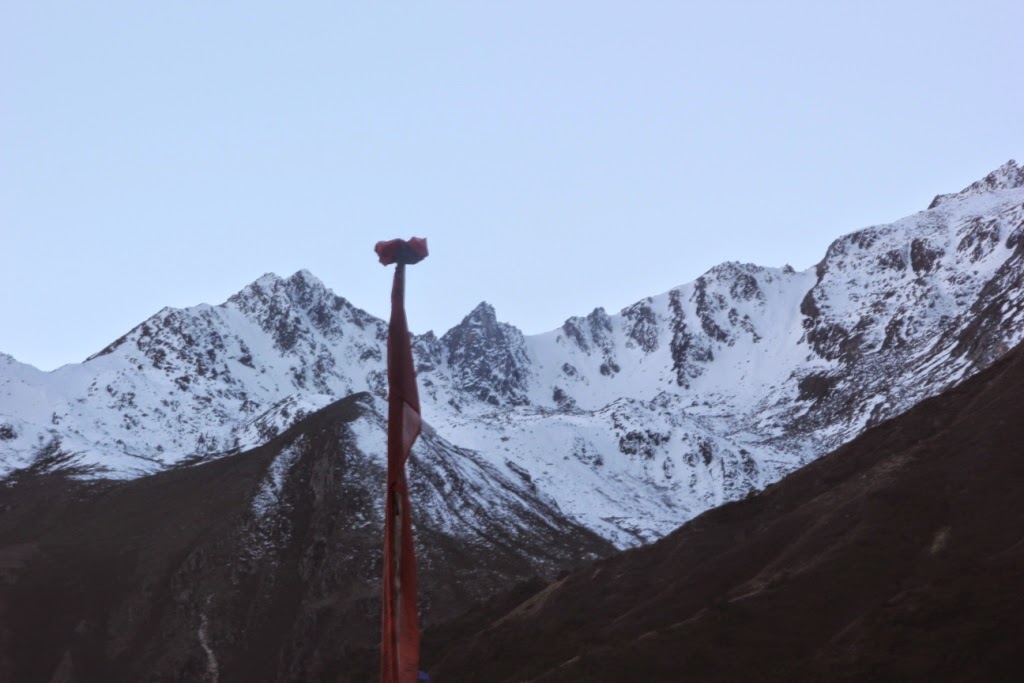DAY 7
– GANGTOK – RAVANGLA – PELLING
After
seeing Gurudongmar Lake, Zero Point and Rumtek Monastery, today’s plan was to reach
Pelling. You can take the direct route to Pelling from Gangtok or take a detour
via Ravangla or Namchi and then reach Pelling. In Ravangla you can see the
Buddha Park and the Rabong Monastery whereas in Namchi you can see the replicas
of Char Dham. We chose to go via Ravangla.
 |
| Rabong Monastery |
We
had already booked an Innova through our hotel (for Rs 4,000) from Gangtok to
Pelling. We were supposed to leave at 8:30 am but left at 10:00 am. The driver
was late as he had returned from North Sikkim today morning itself. It made
sense to let me sleep and start late from Gangtok and as Pramod said, “We can’t
put our family at risk”.
 |
| Can you see the small statues of Buddha? |
Pelling
is in west Sikkim and is around 140 kms from Gangtok making it approx 5 hours drive.
As we had decided to take a longer route and see Ravangla on our way to Pelling
we took around 8 hours to reach Pelling. The driver charged us Rs 1500 extra for
the detour to Ravangla.
The Buddha Park, Ravangla
The
Buddha Park also known as the Tathagata Tsal houses a 130 ft high statue of
Buddha and is located near the Rabong monastery. You need to buy an entry
ticket of Rs 50 per person to this beautiful park. Everything about the park is
grand. The red coloured gate of the park is adorned with intricate Sikkimese
design. Numerous stairs takes you down to the main park.
 |
| Buddha Park, Ravangla |
 |
| Buddha Park Entrance |
In
the park, there are speakers playing the soothing chant of Om Mani Padme Hum,
the chant immediately relaxes you and takes you in a trance. Again a no of
stairs will take you up to the main prayer hall.
 |
| Buddha Park, Ravangla |
Under
the giant statute of Buddha there is a prayer hall. In the middle of the prayer
room a statue of Buddha is kept. All around this room there are numerous colourful
statues of Buddha of the same size. There is a spiral pathway which take you up
so that you can have a view of the Buddha from above. All around the spiral
pathway you can see the entire life of Buddha depicted through paintings. All
around this pathway white colour silk cloth was tied up.
 |
| Huge Cup of water at Buddha Park, Ravangla |
Next,
we walked around the main building. Prayer flags were put up around the walkaways
which were fluterring with the wind. Around the giant Buddha on the walkway, seven
huge golden colour cups of water are kept. How can there be no prayer wheels?
Just behind the prayer room you will find prayer wheels in golden colour.
 |
| Golden Prayer Wheels at Buddha Park, Ravangla |
 |
| Buddha Park, Ravangla |
The
Buddha Park is beautifully maintained. Manicured gardens, flowers, and
fountains - everything is perfect. The Park has a shop where you can have maggi
and aloo chiwda. There are two shops from where you can buy souvenirs for your
loved ones.
Rabong Monastery
Rabong
Monastery is located just behind the Buddha Park. When we went to the monastery
it was closed. So we could see it only from outside. Since the monastery was
closed, there was hardly any tourist. We had the entire place to ourselves. The
monastery is simple but beautiful.
 |
| Prayer Wheels at Rabong Monastery |
 |
| Rabong Monastery, Ravangla |
There
are a line of red coloured prayer wheels when you enter the monastery premises.
On your left you will find the monastery. Few steps up and you are at the
beautiful monastery.
 |
| Line of prayer wheels at Rabong Monastery |
 |
| View from Rabong Monastery, Ravangla |
We
took around two hours to see the Rabong monastery and the Buddha Park. After
the Buddha Park, we went to another monastery located in Ravangla – Bon Monastery.
It is a very small and simple monastery.
 |
| Beautiful Rabong Monastery, Ravangla |
 |
| Rabong Monastery, Ravangla |
Continuing
our journey, we reached Pelling around 6:00 pm. Our Hotel was located at upper
Pelling - two mins walk from the new helipad. We had pre booked two rooms in
this hotel on the top floor so that we can enjoy the majestic Himalayan range
from our rooms.
Since
we were hungry we ordered for tea and pakodas. Around 8:00 pm we went
downstairs for dinner. Post dinner, we arranged for a car through the hotel
reception for tomorrow’s sightseeing in Pelling.
Points
to remember:
- As the sun sets early here start your day early.
- Book an Innova, bolero or a Xylo for a comfortable travel. As the roads are bad and travel in Sumo or Maxx can be cumbersome.
- Although the distance between places is not far because of the rough terrain it takes a considerable time to go from one place to another. So plan accordingly.
- Please carry warm clothes including sweater, jacket, cap, mufflers, socks and gloves. Wear shoes and not sandals or chappals.
- While going to Pelling from Gangtok take a diversion to Ravangla and see the Buddha Park and Rolong Monastery.
- Sikkim is plastic free zone. Please don’t litter and maintain the beauty of nature.
- Please remain quiet, maintain the discipline and follow the rules at Monasteries and other religious places.

















































